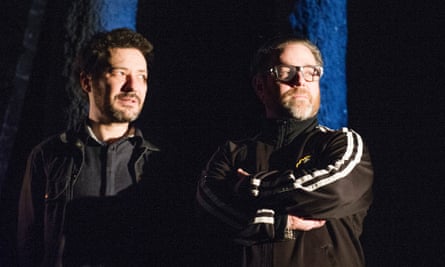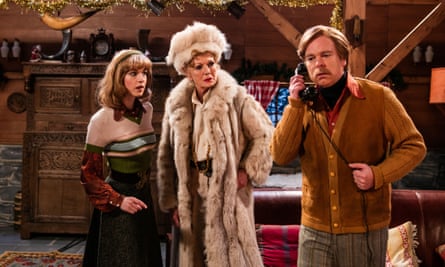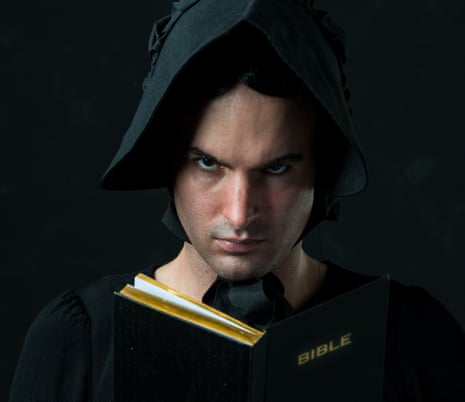The buzz around Australian standup Nick Coyle’s latest offering Queen of Wolves suggested a show that not only tickles the funny bone but chills the marrow. It finds Coyle cross-dressing as Victorian governess Frances Glass. Prim, poor and desperate, she arrives at Blackbell House – out on the windy moors – only to find that her intended infant charges have died in mysterious circumstances. What follows is the story of Frances’s bid to stay alone in the haunted house for six weeks, preparing it for sale.

I may not be the best person to judge how spine-tingling the show is, given that, at the slightest suggestion of scary, I’m an instant bag of nerves. I’m the kind of comedygoer who watched this summer’s horror-comedy hit, Rob Kemp’s The Elvis Dead, through the gaps between his fingers – the OTT goriness of its source movie, Evil Dead II, being too much for my delicate constitution. So it’s far from definitive when I say that, yes, Queen of Wolves gave me the heebie-jeebies – albeit mildly. One review called it as scary as West End frightener The Woman in Black, which is way over the top. The Woman in Black petrified me; Coyle’s show raised a few goosebumps.
But that’s fine; we’re not comparing like with like. As a comedian, Coyle’s responsibility is to make us laugh – and he joins an illustrious line of comics who’ve used horror tropes to do so. The League of Gentlemen are an obvious reference point. Reece Shearsmith and Steve Pemberton’s Inside No 9 may be the standout creepy comedy of our current moment. Jeremy Dyson’s West End hit Ghost Stories tilted the balance more towards screams than laughs, but only slightly. Dyson’s co-creator Andy Nyman keeps both chills and laughter in play as director of Derren Brown’s stage work.

Nyman and Dyson developed a philosophy of spooky comedy – they call it “scun”, from scary and fun – on which Coyle, for all I know, may be drawing. But there are plenty of acts who focus exclusively on spoofing horror rather than recreating its effects – of which Garth Marenghi’s Netherhead, the 2001 Perrier award-winner that launched Richard Ayoade and Alice Lowe on to an unsuspecting world, may be the standout example.
Coyle’s show is in the former camp: it takes the mickey, yes, but it wants to take your breath away, too. And it doesn’t need to stint on one to pull off the other. Yes, it’s undermining genre convention from the off, as Frances plays chicken with the spooky thunderclaps on the soundtrack. But that irreverence coexists quite easily with the show’s more sinister effects. Haunting strings and crepuscular sounds underscore most scenes, even if you register their unsettling impact only when a sudden blackout propels you six inches out of your seat. Coyle can joke as much as he likes about the cheap special effects (“Stop! Stop pulling that string!”) but when the furniture in Blackbell House starts moving of its own accord, it feels uncanny all the same.

Of course, there’s probably a limit to how scary comedy can be. Real, gut-churning terror doesn’t have much to do with laughter. But further down the scale, being spooked and being amused can start to resemble one another. They’re both about feeling unstable, uncertain of the ground you’re standing on. They’re both about bracing yourself, consciously or otherwise, for an imminent surprise – a punchline, a severed head, a custard pie in the face, a corpse sitting bolt upright. (“A laugh is the same as a scream. It’s an outpouring of something,” as Pemberton said of Inside No 9 earlier this year.) Both comedy and horror operate on a cycle of tension generated then defused.
Watching Queen of Wolves, I kept scanning the stage, trying to anticipate and fortify myself against the next shock. That’s not such a dissimilar process to trying to second-guess a comedian – where the joke is coming from, where it’s heading. Finally, the best of Coyle’s show, for me, is the pastiche of buttoned-up Victorian womanhood. Frances’s dumbshow of revulsion is a sight to behold when the very idea of murder is mooted; and the ditty she trills when spring-cleaning Blackbell House (“O, the rabbit and the lark!”) is, given the circumstances, hilariously innocent. But the gasps are as much a part of the experience as the laughs, and they feed off one another, like a hungry demon off his virgin bride.

Comments (…)
Sign in or create your Guardian account to join the discussion